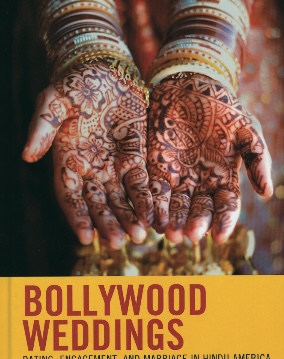Kavita Ramdya proposes that a new marriage paradigm has taken hold amongst our second-generation in Bollywood Weddings: Dating, Engagement, and Marriage in Hindu America. Dr. Ramdya, an independent researcher in American studies, explores the working dynamic of the Indian-American engagement and wedding. The London-based author conducted her field work–if the term applies–in New York City where she attended ten weddings and receptions, starting with her own in 2005.
In her work the writer openly, quizzically and honestly peers into the depths and subtleties of the marital patterns of Indian-American Hindus from the latter half of the twentieth century to today. Ramdya’s research and findings are enhanced by wedding couples’ personal thoughts and interviews. It is a fascinating interplay, mingling contrasting insights in an expose on the symbiotic rapport of Indian and American marriage customs, from the first meeting to the reception party. Bollywood Weddings also goes beyond marital culture into what it’s like to be a second generation Hindu in the US. It’s a rich commentary on American sociology and the Indian-American experience as a whole.
“Although the focus in this book is negotiating engagement and marriage,” she explains in her introduction, “I am interested more broadly in the negotiation of culture. I look at marriage to make sense of how second-generation Indian-American Hindus negotiate two vastly different cultures that represent dichotomous sets of values.”
Ramdya discovered “an unexpected third culture”–weddings with attributes both ancient and modern, both East and West. At one extreme was the marriage of Savita and Dev when they were still graduate students. They rejected the family’s desire for a large Hindu wedding conducted by a priest and opted for a simple civil ceremony at a friend’s house conducted by a magistrate, also a friend. But that didn’t mean they were going to leave tradition out altogether. “Theirs is one of three [of the ten] where the bride and groom were interested in not only displaying their Indian heritage at their ceremony by invoking Hindu spirituality and having friends perform the tabla, but also conveying their symbolic ethnic American values by walking down an aisle and reciting vows.”
At the other end of the spectrum was Hamsa and Nalin’s wedding in which the groom rode in on a white horse, followed by dancing and clapping guests–just like you would experience in Gujarat. The ceremony was straight out of India, with one addition, a walk down the aisle. Reports Ramdya, “Hamsa’s walk down the aisle conveys her symbolic ethnic American capital in her otherwise Indian-Hindu wedding ceremony. Still, Hamsa stressed the authenticity of her wedding and reveled in her guests’ wonderment at her pure Hindu wedding ceremony.” The reception that followed was a “hybrid American-Bollywood event. The Beatles, Western wedding songs, Indian bhangra and Bollywood film music were all played and performed.”
Drawing in Bollywood Weddings what she calls “surprising conclusions,” Dr. Ramdya discovered, “instead of choosing either India or America, this [second-generation of Indian-American Hindus] embraces both cultures in the search for a spouse, marriage proposal and wedding planning.”
Bollywood Weddings, Kavita Ramdya, Lexington books, 4501 Forbes Blvd, Suite 200, Lanham, Maryland 20706 USA November, 2009, us$24.95 paperback. 99 pages. www.lexingtonbooks.com [http://www.lexingtonbooks.com]


